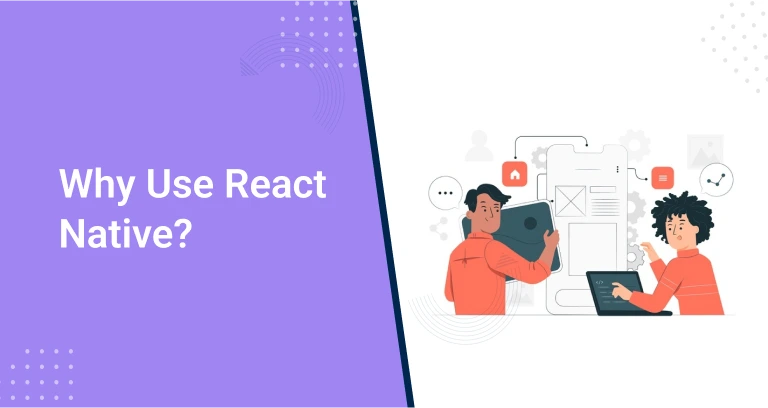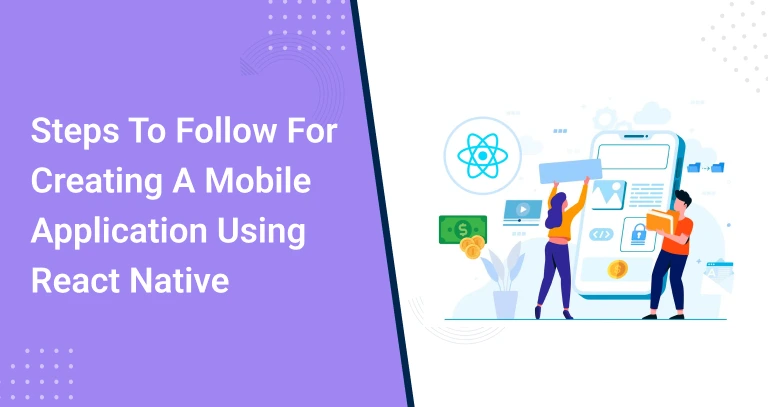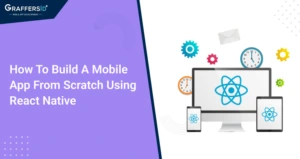The upheaval, or say, the breakthrough from the past, has created a pressing need for a shift from business models with real-life approaches to digital platforms with a technological approach to solving human problems and their growing needs. Developers these days have come up with excellent ideas to build a mobile app using React Native that runs on both iOS and Android.
With the view of digital platforms revolving as the central focus for our everyday practices ranging from shopping to communication, from global awareness to entertainment, from gaming to healthcare; hence with, the years-old businesses to new start-ups all have realized that it is indispensable to keep up with digital platforms to survive in the market in this century.
React Native has been a sky-scraping tool for the app development industry. And also, it’s been most suitable for companies to do the same.
What is React Native?
React native is a framework for building native apps on Android and iOS using JavaScript.
React-native came into the limelight for the first time in 2015 with the launch of the massive success of Facebook. Its popularity and usage gradually increased, and now it is the first choice of every developer. Most apps, from social media apps like Instagram and Facebook to human help apps like Uber Eats, are built with React-native.
Why React Native?

Well, anyone reading this article might undoubtedly be questioning the same. So, here’s the answer that would probably change your doubtful sight to a convinced view for the use of react-native.
There are plenty of reasons for REACT-NATIVE to win developers’ hearts globally.
-
Cost-Effective
Most companies prefer the development of an app using React Native because they do not need to hire two teams of developers maintaining 2 code bases, one for iOS written in Swift or Objective C and another for Android written in Java or Cartland. Instead, by react native with a single codebase that can run on both iOS and Android, the company saves the funds and the efforts of hiring multiple teams.
-
Time Efficient
It saves time after creating two native apps that could probably facilitate iOS and Android separately to a single codebase that could cross-platform and run in both. This is possible only with the use of React-native.
-
User Friendly
React-native is highly user-friendly. It is easy to learn, well-assisted, and requires only basic knowledge of JavaScript like style, text, etc. Most importantly, one does not require prior knowledge of iOS or Android programming.
-
Auto-Update
React-native has a fantastic feature wherein “Out-The-Air” updates can be made on the backend side even when the user is actively using the app and is reflected immediately at the user interface. It is also made accessible instantly. And insightfully or more specifically, the user does not have to go to the Play Store or an app store to make the required update since it gets updated automatically. This feature is also called “Fast Refresh.”
Apart from all these benefits mentioned above of react native, the most fantastic feature of it is it allows easy migration of UI tools and many other tools to personalize the application to its best.
So, these magnetic properties and enduring react-native features would have caught all your attention.
Read Also: React Native vs Xamarin vs Ionic vs Flutter: Which is better?
How to Build a Mobile App using React Native?
There are two ways to get the best output or to get the finest application done; one is by hiring a MERN stack developer and another is by developing the same by using react-native and having basic knowledge of JS hand in hand.
So, let’s look into both approaches in-depth:
Hire a MERN Developer
Here MERN stands for MongoDB, Express.js, ReactJS, and Node.js. Fundamentally, MERN is an assemblage of technologies that helps in the development of an app and makes the process faster and easier.
The primary purpose of the MERN developer is to develop an application using JavaScript only. [a MERN developer works on developing and designing both]
These developers have a thorough knowledge of designing and are specifically well-equipped with all modified features, launched updates, and revised properties of JavaScript.
Hiring a remote MERN developer is advisable since it facilitates the speedy delivery of a practical solution. Also, remote hiring enhances the project’s scalability and magnificent flexibility. Before hiring remote developers, you will need to change your management style and workflows, including plans, functions, etc., to accommodate or successfully incorporate the remote workers.
Another great or greatest of all advantage is its cost-effective technique since it eliminates the overhead costs of developers for the company.
So, building a mobile app using React Native by a developer is quite advantageous.
Read Also: Companies That Use React Native Successfully
Factors to Keep in Mind While Hiring:
- The motive of the project
- Requirements
- App Type (small, basic app, large sized, complex app, etc.)
- Funds availability
- Designing qualifications
- Programming skills required
- Soft skill assessments
If one hires a MERN developer who could use native JS and easily accommodate with react native, that will increase developmental capability and productivity and help market expansion. Since there are no fund expeditions over different teams hiring for iOS and Android, the same can help in spending funds over app engagement.
Also, hiring remote MERN developers is tremendously advantageous since they enhance the company’s productivity, increase efficiency, and save assets of office space costs and accommodation costs.
Develop the same by using react-native and having basic knowledge of JS hand in hand.

Since we are starting to build a mobile app using React Native straight from scratch, there are some extra steps you need to follow.
-
Download NPM and node.js in your system.
Note: if you already have it done prior, jump straight to step 2.
-
Install Expo CLI
Well, there are two ways to build React native apps:
- Plain react native, i.e., react native CLI or say react-native command line interface (It is the priority of people who have basic knowledge of Android and iOS programming)
- Expo CLI (set of tools and framework that sits on top of react native and hides a lot of complexity from us it makes; it is incredibly fast and easy to build react native apps.
Note: If you have never done any mobile development before expo is the way to go, you can build and run your first app within a few minutes.
So, since we are discussing things from an elementary and primitive level, we will go ahead with expo CLI.
To do so, go to a new terminal on the system, and type the command as $ npm install -g expo-cli
-
Start to React Native Project.
- Once you have installed the expo client, you will be asked to choose the template and the workflow. So, choose managed workflows over bare workflows because bare workflow again requires building an iOS and an Android file which the managed workflow doesn’t need) and opt for a blank template. Once it is done, type the name of the project and then wait for the CLI to generate files and extract packages from NPM.
- To test your application, you have multiple choices like an iOS simulator, website, android stimulator, or mobile device, depending on your working environment. You can hire one from a mobile app development company if you don’t have one. Once done, you can easily install the expo app.
- Now open the app.js file, a primary react native component. Here we import react-native parts, stylesheet, text, and view from reacting Native. Also, note here that we don’t have HTML attributes like an anchor, div, etc. instead, we have function and class components. Still, it’s always better to use function components because they are more straightforward and more lightweight hence, function.app ().
- Introduce style object in return command under function.app
- Now with style as an object and stylesheet. Create and add all style commands required (create contains a property called container that includes all the styles).
-
To add multiple screens to react native apps.
Use conditional rendering to add multiple screens to your React native app.
-
Fetch data in React-native.
- For loading, we use the effect hook to perform the slide function. We will be fetching the data from the rest API server. To do so, go to app.js and add API_KEY and API url under the function app () object.
- By use of react.setstate() add item and store information.
- Call the fetch method in the estate hook to fetch the data.
- Add fetched articles under the <home> component using data properties.
- Now the data has been fetched, and it is also passed to the home component. So now you can hire a front-end developer to make the required modifications. (in terms of designing and other styling components)
- Now call JS map (), which translates these properties and the components we use to their native widgets and displays the data on the screen.
- Finally, our app screen will show the data stored in the backend.
- Now, whatever appears on your screen post the previous step seems like a random collection of words. So, it needs proper style, size, and font; now, it is a complete game of UI designing.
- You can make it more engaging and attractive by adding images, statistics, URLs, etc. You can add any design element that you wish under the stylesheet. Create a hook.
- Once all design work is done, the app is ready to be used.
Popular Libraries and Packages Commonly Used in React Native Development
One of the significant advantages of React Native is its vibrant ecosystem of libraries and packages that simplify and accelerate the development process. In this blog post, we’ll explore some popular libraries and packages commonly used in React Native development.
-
React Navigation:
- One of the most critical aspects of mobile app development is navigation. React Navigation is the go-to library for handling navigation in React Native applications.
- It provides a wide range of navigators like Stack Navigator, Tab Navigator, and Drawer Navigator, making it easy to set up and customize navigation flows in your app.
-
Redux:
- State management is crucial for maintaining the application’s data and ensuring a seamless user experience. Redux is a popular state management library that is commonly used in React Native development.
- It allows you to manage your app’s state in a predictable and centralized way, making it easier to debug and maintain.
-
Axios:
- Most mobile applications require interaction with external APIs. Axios is a promise-based HTTP client that simplifies making network requests.
- It’s easy to use, and it supports features like request and response interception, request cancellation, and automatic transformation of JSON data.
-
AsyncStorage:
- AsyncStorage is a simple, unencrypted, asynchronous, persistent, key-value storage system that is widely used for storing small amounts of data in React Native applications.
- It’s a great choice for storing settings, user preferences, or small amounts of cached data.
-
React Native Elements:
- Building a visually appealing user interface is essential. React Native Elements is a popular UI toolkit that provides a set of customizable, pre-built UI components.
- It simplifies the creation of beautiful, consistent, and responsive UIs for your React Native app.
-
React Native Vector Icons:
- Icons play a crucial role in mobile app design. React Native Vector Icons is a library that offers a wide selection of high-quality icons.
- It supports various icon sets like Material Icons, FontAwesome, and more, making it easy to integrate icons into your app.
-
Firebase:
- Firebase is a real-time database and authentication platform provided by Google. It’s commonly used in React Native applications for handling user authentication, real-time data synchronization, and push notifications.
- Firebase simplifies backend development and allows developers to focus on the frontend.
-
Lottie:
- Lottie is an animation library that enables you to add beautiful and engaging animations to your React Native applications.
- You can create animations in Adobe After Effects and export them as Lottie files for easy integration into your app.
-
React Native Gesture Handler:
- Handling touch gestures and interactions is vital for creating a responsive and intuitive user experience. React Native Gesture Handler is a library that allows for efficient gesture handling in React Native applications.
- It enables you to create complex gestures and animations while maintaining high performance.
-
Fastlane:
- Fastlane is a set of tools that automate the app deployment process, making it easier to release updates to the App Store and Google Play.
- It simplifies tasks like code signing, beta testing, and the submission of app updates, saving developers valuable time.
React Native’s extensive library ecosystem significantly contributes to its popularity among mobile app developers. The libraries and packages mentioned above are just a few of the many available. When working on a React Native project, choosing the right libraries and packages can save you time and effort, while also improving the quality and functionality of your application. Stay updated with the latest developments in the React Native community to make the most out of these resources and enhance your app development process.
Can You build a complex app with React Native?
React Native is a robust choice for building complex mobile applications, especially if you value cross-platform compatibility, rapid development, and a strong community. It is suitable for a wide range of app types, including e-commerce platforms, social networks, productivity tools, and more. However, when considering React Native for complex apps, carefully evaluate your project’s specific requirements and performance needs. In some cases, native development or a hybrid approach may be more appropriate. Ultimately, React Native empowers developers to build complex apps efficiently while balancing the advantages and limitations of the framework.
What are the prerequisites for building a mobile app using React Native?
React Native ability to create cross-platform apps with a single codebase has made it a go-to choice for developers. However, embarking on a React Native mobile app development journey requires more than just enthusiasm. In this blog post, we will delve into the key prerequisites that aspiring developers should consider before diving into building a mobile app using React Native.
Fundamental Knowledge of JavaScript:
React Native is built on top of JavaScript, so having a solid understanding of this programming language is paramount. Developers should be comfortable with concepts like variables, functions, loops, and objects. A deeper knowledge of ES6 (ECMAScript 2015) features, such as arrow functions and classes, will also be beneficial in writing concise and modern React Native code.
Understanding React Basics:
Since React Native is an extension of React, having a fundamental understanding of React is crucial. Developers should be familiar with React components, state, props, and the component lifecycle. This knowledge forms the foundation for building user interfaces in React Native.
Node.js and npm:
React Native relies on Node.js for its backend, and npm (Node Package Manager) for managing dependencies. Ensure that you have Node.js installed on your development machine, as it will be used to run the React Native server. npm will be essential for installing and managing third-party libraries and packages needed for your project.
Development Environment Setup:
Setting up a development environment for React Native can be a complex process. Depending on your operating system, you may need to install Xcode (for iOS development on macOS) or Android Studio (for Android development). Additionally, configuring the React Native CLI and debugging tools is crucial for a smooth development experience.
Integrated Development Environment (IDE):
Choosing the right IDE is essential for productivity. Popular choices for React Native development include Visual Studio Code, Atom, and WebStorm. These IDEs provide features like syntax highlighting, auto-completion, and debugging tools that streamline the development process.
Exposure to Native Development Concepts:
While React Native abstracts many complexities of native app development, having a basic understanding of native concepts can be advantageous. Concepts such as native modules, native UI components, and platform-specific code can be beneficial when customizing your app’s behavior for different platforms.
Version Control with Git:
Git is an essential tool for version control and collaboration. Knowing how to use Git for tracking changes, branching, and merging is crucial for maintaining a clean and organized codebase. Platforms like GitHub and GitLab are commonly used for hosting repositories and collaborating with team members.
Responsive Design Principles:
Building mobile apps requires a good grasp of responsive design principles. React Native employs a flexbox layout system similar to the web, making it important for developers to understand how to create layouts that adapt to various screen sizes and orientations.
Building a mobile app using React Native is an exciting venture, but it demands a solid foundation in JavaScript, React, and the associated development tools.
Elevate Your Project with Top Remote React Native Developers from GraffersID
Are you in search of highly skilled remote React Native developers to bring your mobile app project to life? Look no further than GraffersID. Our team of dedicated and experienced developers is ready to take your project to the next level. With a proven track record of delivering outstanding React Native applications, we bring a wealth of expertise to the table. Whether you’re starting a new project or need additional resources to accelerate your development, GraffersID has the talent and commitment you’re looking for. Don’t miss out on the opportunity to work with some of the best in the industry. Contact us today and let’s discuss how we can make your project a resounding success!
To Sum Up
React Native has the developers’ whole hearts and hopefully yours by now. Hiring a remote React Native developer is equally advantageous in the final output that is more design-versed, eye-enticing, and more productive. From planning to designing, the React Native developer knows it all to their best, so to make an app more scalable with less time-consuming and cost-effective, the React Native developer should be your only choice.
If you really want to lessen your burden, get in touch with GraffersID to hire remote React Native developers who have good experience and knowledge.




